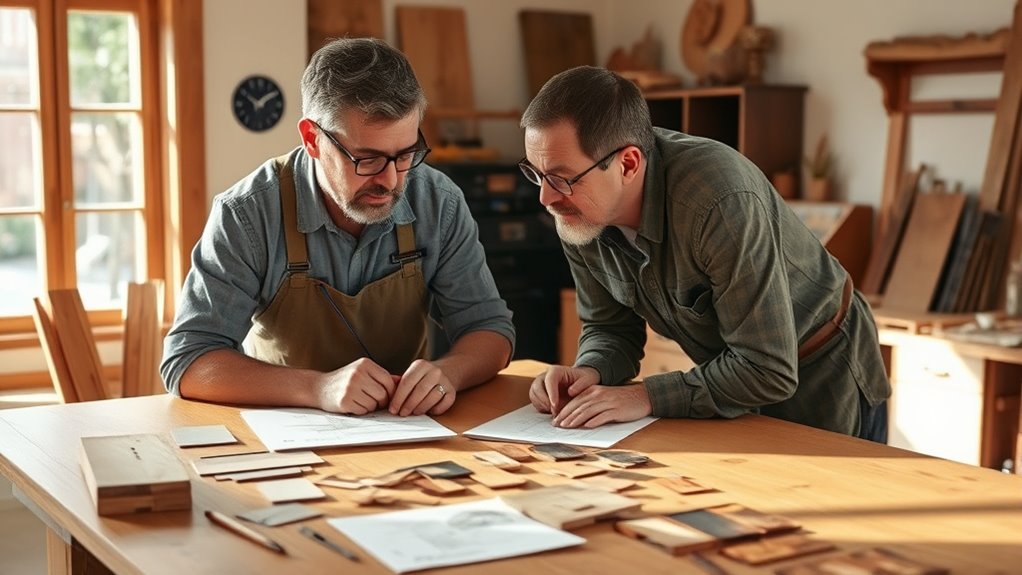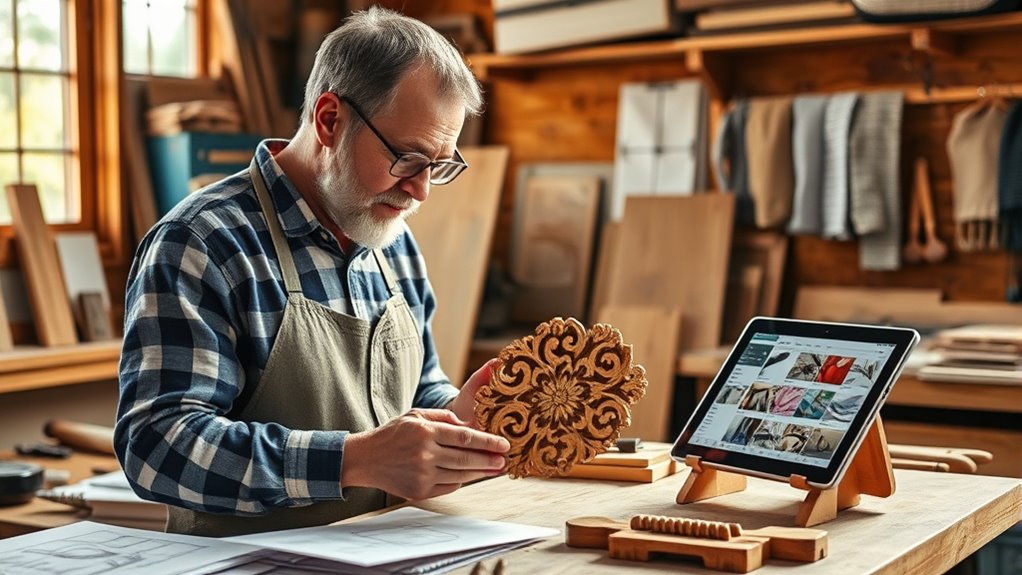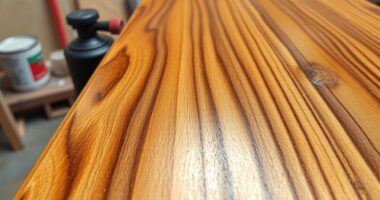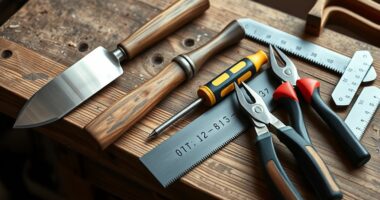To truly understand your customers in custom woodworking, focus on their functional needs like durability and practical design, along with emotional desires such as personal style and unique touches. Communicate openly using visuals, samples, and updates to clarify ideas and build trust. Creating a seamless customer journey and providing exceptional service fosters loyalty. Mastering operational efficiency and tracking satisfaction through KPIs will help you meet expectations consistently—if you want to learn more, stay with us.
Key Takeaways
- Recognize both functional needs, such as durability and space efficiency, and emotional desires like personalization and style.
- Use visual aids and samples to clarify design concepts and align customer expectations early.
- Maintain open communication with regular updates, transparent timelines, and clear project scope to build trust.
- Incorporate personalized features that reflect individual tastes, making pieces meaningful and unique.
- Gather feedback through satisfaction scores and testimonials to continuously refine offerings and enhance customer relationships.
The Significance of Personalization in Custom Woodworking

Have you ever wondered why personalized touches make custom woodworking so valuable? It’s because personalization lets you create unique, tailored designs that reflect your style and meet your exact needs. Unlike mass-produced furniture, custom pieces fit perfectly into your space, even in awkward nooks or unusual layouts. You can incorporate your personal tastes, making each item one-of-a-kind, from crown moldings to built-in shelves. Working closely with woodworkers, you ensure your vision and lifestyle are captured perfectly. Personalization also boosts functionality, maximizing storage and adapting to your organizational habits. Beyond utility, these handcrafted pieces carry emotional significance, often becoming family heirlooms. Their distinctive craftsmanship and thoughtful design enhance your home’s character, making every piece not just beautiful but meaningful. Additionally, understanding custom woodworking materials helps you select the best options for durability and aesthetics, ensuring your personalized pieces stand the test of time. Exploring material options can also influence the overall style and longevity of your custom furniture, and knowing about the importance of craftsmanship in custom woodworking can help you appreciate the skill involved and make informed choices. Moreover, being aware of the influence of technology on creativity can inspire innovative approaches to your project and integrate modern techniques with traditional craftsmanship. Furthermore, being aware of AI security vulnerabilities can aid in safeguarding digital assets related to your projects and designs.
Recognizing Functional and Emotional Customer Expectations

Understanding your customers’ needs goes beyond personalization; it requires recognizing both their functional and emotional expectations.
Functionally, they want durable, high-quality craftsmanship that ensures longevity. Practical design is essential—whether it’s maximizing storage or saving space—so the piece fits their daily needs. Timely delivery and clear communication about costs help build trust and prevent misunderstandings. Offering samples or swatches empowers customers to make informed choices about materials and finishes. Additionally, understanding the importance of vetted products ensures safety and quality in the final piece. Proper selection and maintenance of quality materials can significantly impact the durability and appearance of the finished item. Recognizing the importance of efficiency in heating systems can help tailor products to meet energy-saving goals and optimize performance. Incorporating customization options allows clients to feel more connected to their unique piece, enhancing emotional satisfaction. Paying attention to customer feedback helps refine the design process and better meet client expectations.
Effective Communication for Understanding Customer Desires

How can you guarantee that your communication effectively captures your customers’ true desires? Start by establishing open channels—regular updates and progress reports build trust and keep clients engaged. Utilizing cryptocurrency market trends can also help you anticipate client needs based on current market dynamics. Clearly define project timelines, materials, and costs upfront to set accurate expectations. Use detailed information, like wood guides, to help clients make informed choices. Incorporate visual aids such as drawings, samples, and high-quality imagery to clarify design elements and prevent misunderstandings. Promptly address concerns or issues to maintain satisfaction and demonstrate reliability. Additionally, understanding appliances labs and testing procedures can ensure that your projects meet high standards of safety and quality. Recognizing the importance of sound healing science can inspire creative ways to incorporate calming elements into your workspace, fostering better communication and relaxation. Incorporating performance testing and quality assurance processes can further enhance client confidence and project success. Utilize tools like social media, specification sheets, and client visits to enhance understanding. By actively listening to feedback and maintaining transparent, ongoing communication, you ensure your clients’ desires are heard, understood, and incorporated into every project stage. Implementing a financial information process can also help clarify budgets and resource allocation, preventing misunderstandings related to project costs.
Tailoring the Customer Journey: From Inspiration to Decision

After establishing clear communication with your clients about project details and expectations, the next step is to tailor their entire journey from initial inspiration to final decision. Start by inspiring them through eye-catching visuals—photos, videos, and blog posts—that showcase your custom design possibilities. During consideration, address concerns about costs, timelines, and aesthetics by providing transparent pricing, realistic timelines, and educational resources. To help clients feel confident, offer 3D renderings, sketches, and samples of materials, along with testimonials from satisfied customers. Create a welcoming environment in your showroom or workshop, where they can see past projects and handle material samples. Personalized interactions and proactive updates throughout the process keep clients engaged and reassured, guiding them smoothly toward making confident, satisfying decisions. Additionally, understanding customer needs and preferences facilitates better customization and enhances overall satisfaction. Recognizing the importance of spiritual guidance can help you connect more deeply with clients’ values and desires, ultimately fostering stronger relationships. Furthermore, paying attention to dream symbols and their meanings can provide insights into clients’ subconscious desires and emotional states, enriching your ability to serve their unique visions. Incorporating AI security measures into your business operations can also protect sensitive client information and streamline your customer service processes, ensuring a secure and efficient experience. A thorough understanding of historical farmhouses can also inspire unique design elements that resonate with clients’ appreciation for heritage and craftsmanship.
Strategies for Exceptional Customer Service in Custom Projects

Exceptional customer service in custom projects hinges on effective communication and personalized attention. You should provide clear information about materials, options, and pricing upfront, helping clients make informed choices. Incorporating clear communication fosters trust and ensures expectations are aligned from the start. Respond promptly to inquiries and concerns to build trust and demonstrate your commitment. Keep customers updated throughout the process with regular progress reports, managing expectations and avoiding surprises. Use technology like virtual consultations and 3D renderings to enhance understanding and visualization. Showcase your craftsmanship through quality photos, behind-the-scenes content, and testimonials to build credibility. Engage with clients on social media by responding to comments and sharing their project stories. By combining transparency, personalization, and active engagement, you create a positive experience that encourages loyalty and sets your custom woodworking service apart.
Optimizing Operations to Meet Customer Needs Efficiently

To meet customer needs efficiently, optimizing your operations is key. Use software to streamline the design process, enabling quicker iterations and better alignment with client preferences.
Optimizing operations with smart software enhances design efficiency and better aligns products with customer needs.
Prioritize sustainable materials to appeal to eco-conscious customers and cut costs by 10-15%. Maintain a 3-5 day turnaround on projects to ensure timely delivery and satisfaction.
Invest in high-quality tools to reduce material rework by up to 15%, enhancing product quality. Implement lean manufacturing practices to cut waste by 25%, and adopt just-in-time production to respond swiftly to demand fluctuations.
Streamline changeovers with SMED techniques, and leverage advanced software for seamless workflow. Negotiate bulk material purchases to save up to 20%, ensuring consistent quality while controlling costs.
These strategies help you operate efficiently and meet customer expectations effectively.
Using KPIs to Enhance Customer Satisfaction and Loyalty

Using KPIs effectively is essential for boosting customer satisfaction and loyalty in your woodworking business. Tracking metrics like the repeat customer rate helps you understand loyalty levels; aiming for 30-40% ensures stability and reduces marketing costs by focusing on existing clients.
Monitoring customer retention rates, ideally between 60-80%, reveals how well your brand builds trust and encourages repeat business. Customer satisfaction scores, including Net Promoter Scores, highlight how well your products meet expectations and identify areas for improvement.
KPIs such as response time and issue resolution directly impact satisfaction and loyalty. By leveraging these metrics, you can refine loyalty programs, personalize follow-ups, and align craftsmanship with customer needs—ultimately strengthening relationships and ensuring long-term success.
Frequently Asked Questions
How Can I Ensure My Custom Woodworking Project Matches My Lifestyle?
To guarantee your custom woodworking project matches your lifestyle, start by analyzing your daily routines and household needs. Consider space constraints, future growth, and how you use each area.
Choose materials and designs that reflect your personal style, balancing aesthetics and functionality. Prioritize features that enhance convenience, like multi-use furniture, and select durable materials suited for your environment.
This approach guarantees your custom pieces truly support and complement your lifestyle.
What Are Common Challenges in Communicating Customer Expectations Effectively?
You face common challenges when communicating customer expectations, like unclear specifications or poor communication, which can cause misunderstandings.
Clients may have unrealistic ideas about materials, timelines, or budgets, making it essential to set clear expectations early.
Use visual aids, active listening, and regular check-ins to keep everyone aligned.
Address language or cultural barriers proactively, and encourage early feedback to prevent issues and guarantee your project meets expectations.
How Do I Choose the Right Customization Options for My Space?
When choosing customization options for your space, start by evaluating how you’ll use the area and what storage or functionality it needs.
Consider durability, style, and how features like lighting or specialized components will enhance usability.
Collaborate with skilled craftsmen to guarantee your ideas translate well into practical designs.
Focus on options that maximize space, match your aesthetic, and fit your lifestyle, making your space both beautiful and highly functional.
What Should I Consider When Reviewing Samples or Prototypes?
Imagine your project as a puzzle—each sample or prototype is an essential piece. When reviewing them, consider visual and dimensional accuracy to guarantee the design fits your space and comfort needs.
Check material choices for durability and aesthetics, and assess functionality like joints and mechanisms.
Clear communication with your craftspeople helps refine details, saving time and costs.
Think of prototypes as your roadmap—guiding you toward a perfect, personalized piece.
How Can I Maintain Quality While Meeting Tight Deadlines?
To maintain quality while meeting tight deadlines, you should optimize your workflow by batching similar tasks and organizing tools for quick access.
Use automation like CNC machines to boost efficiency and precision.
Regularly inspect your work and test materials to catch issues early.
Train your team on best practices, and leverage design software for clear planning.
Outsourcing or partnering can also help meet deadlines without sacrificing craftsmanship.
Conclusion
By truly understanding your customers’ needs, you become a skilled navigator guiding them through a personalized journey. When you listen and adapt, you’re not just building furniture—you’re crafting trust and loyalty that stand the test of time. Think of each project as a story you tell together; the more you tune into their desires, the more your craftsmanship becomes a timeless masterpiece, resonating long after the last nail is hammered in.









